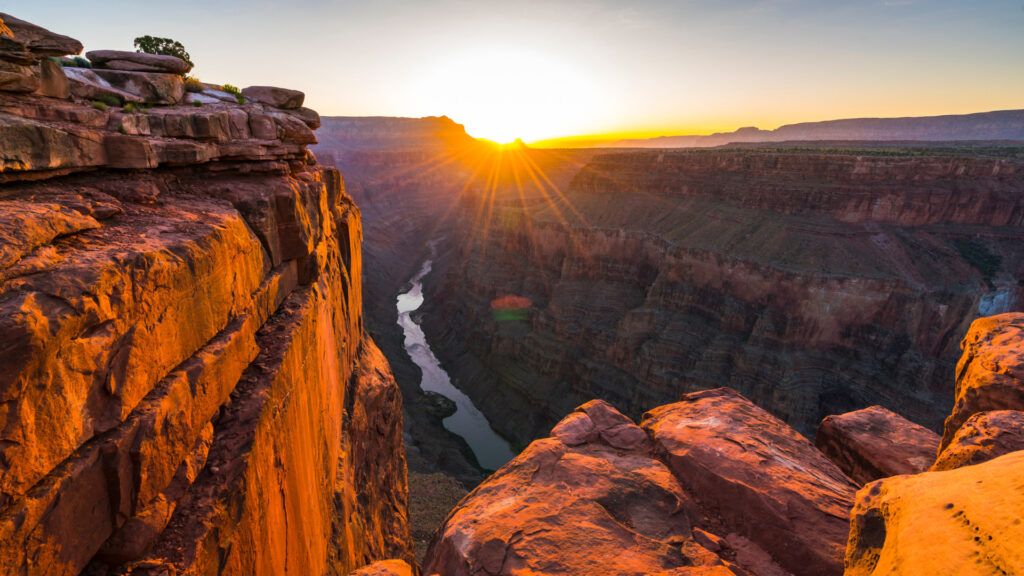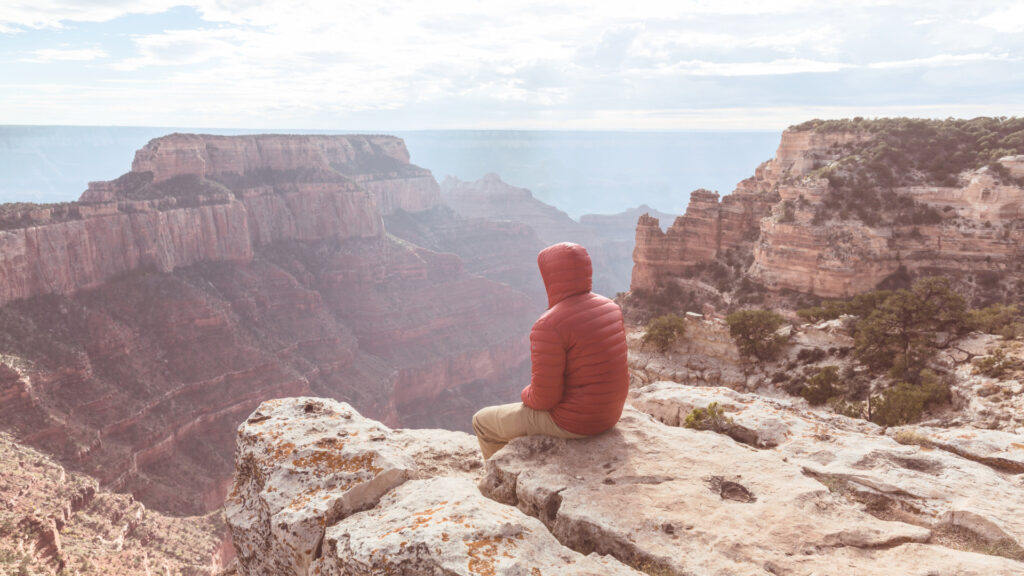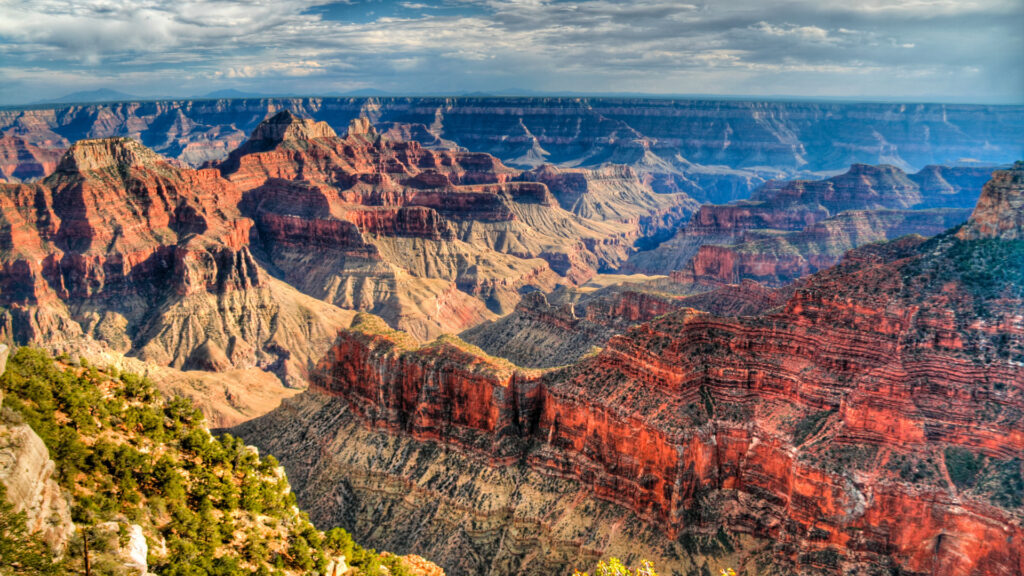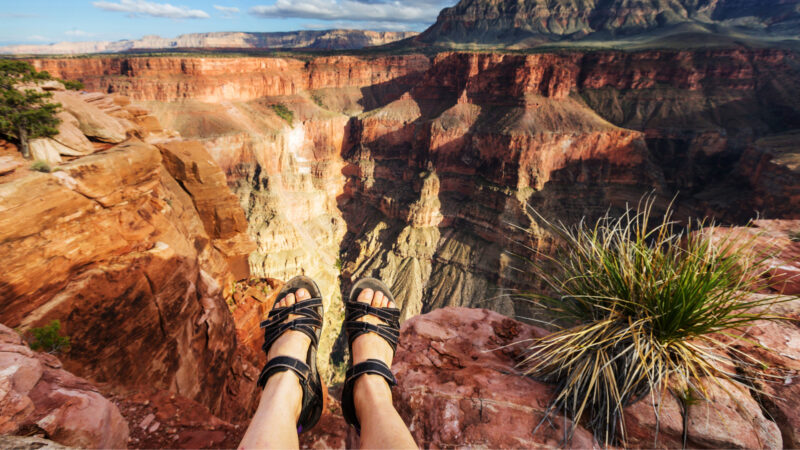Table of Contents Show
Many people plan trips around hiking down to see the floor of the Grand Canyon. Unfortunately, some visitors step too close and take an unplanned trip down to the bottom. Sadly, a fall into the Grand Canyon is almost always fatal.
Many guests see this park for the first time and wonder how many lives it claims in a year. It’s one of the most common questions rangers get asked. Regrettably, it’s more than you’d think.
Today, we will answer this common question and provide tips for staying safe at the Grand Canyon. Let’s get started!
About the Grand Canyon
The Grand Canyon is in the northwest corner of Arizona. Several million visitors travel each year to stand at the rim. Staring before a canyon 277 miles long, 18 miles wide, and a mile deep is hard to comprehend.
Colorful rock formations result from millions of years of erosion from the mighty Colorado River. The layers of sedimentary rock change and tell the history of the area. For many, it’s a giant hole in the ground; however, for several Native American tribes, it’s a sacred place.
The Havasupai, Hualapai, Navajo, and Hopi tribes have inhabited the land for thousands of years. They have a deep connection to the canyon and the grounds surrounding it. Many continue to live in and around the canyon to this day.
This is one natural wonder that everyone needs to experience at least once. Whether you’re a scientist, an adventurer, or a nature lover, the Grand Canyon offers something for everyone. Don’t miss a chance to experience this unforgettable sight.
When Is the Best Time to Visit the Grand Canyon?
While the Grand Canyon is a year-round destination, timing is crucial if you want to take your time exploring. The best times to visit are from March to May and September to November.
By coming during spring and fall, you can take advantage of fewer crowds and milder temperatures. You also may get the bonus of enjoying wildflowers in the spring and foliage in the fall.
On the other hand, summer and winter are some of the worst times to come. Summer is the peak tourist season, and temperatures regularly exceed 100 degrees Fahrenheit.
However, while winter is the off-season, it’s also incredibly unpredictable. The increased elevation means chilly temperatures and the potential for snow.
Ultimately, the best time to experience the area will depend on the activities you plan to enjoy. Consider crowd levels, your budget, and the weather when planning your trip. However, if we’re honest, there’s never a wrong time to appreciate the uniqueness of the Grand Canyon.

Is the Grand Canyon Safe?
The Grand Canyon is a relatively safe place. Unfortunately, like any wilderness area, it has inherent risks associated with visiting and exploring the canyon.
Do accidents happen? Absolutely. However, it’s possible to minimize risks and dangers during your visit.
It’s easy for people to get caught up in the moment. The excitement and emotions get the best of them, and they don’t think clearly. Those that take the proper precautions and minimize risks experience minimal issues.
If you see anyone behaving irresponsibly, report the behavior to rangers immediately. You don’t want them to cause you to fall into the Grand Canyon.
Hazards of Visiting the Grand Canyon
While visiting the Grand Canyon can be an incredible experience, it has some dangers. Planning for them can help you and your loved ones stay safe during your trip.
Dehydration
Dehydration is one of the most common hazards. The dry climate causes water to evaporate quickly, and you can lose fluids rapidly. Dehydration can set in quickly if you are unprepared, especially during the summer.
Rangers often recommend hikers carry a gallon of water per person when hiking, more if it’s during extreme temperatures. Avoid alcohol and caffeine, which typically increase dehydration.
If you have water, drink it. If you pass a water station, fill up your water container. They may not be available in all areas.

Once dehydration sets in, it’s only a matter of time before heat exhaustion and other heat-related illnesses occur. This happens when your body becomes too hot and can’t cool itself fast enough. When temperatures reach well over 100 degrees, it doesn’t take long for heat exhaustion to set in.
Staying hydrated and cool can significantly reduce heat-related illnesses. Take frequent breaks, wear the proper clothing, and get into shade and air conditioning when available.
Avoid hiking during the hottest parts of the day. Trust us; starting a hike at sunrise may not be exciting, but it’s much better than experiencing heat exhaustion.
Keep in Mind: Are you wanting to bring your RV to the Grand Canyon? Then take a look at these Tips for Planning an RV Trip to the Grand Canyon!
Wildlife Encounters
Wildlife encounters are common. Many guests forget that animals are wild and far from tame. You should always keep your distance and avoid provoking them. In addition, do not feed them, and properly dispose of all trash.
If you encounter wildlife while at the Grand Canyon, stay calm. You should avoid running or turning your back on it. When it comes to rattlesnakes, you should never put your hands or feet anywhere you can’t see.
Keep your distance, and do whatever you can to minimize the emotion of the encounter, which can lead to poor decisions.

Flash Flooding
Many hikers forget about the hidden dangers of flash flooding. These can occur suddenly and without warning, especially from July through September.
Heavy rain upstream can cause water levels to rise quickly and with incredible force. With limited cell service, you may not get warning notifications to seek higher ground.
Hikers should stay informed of the weather forecast and be ready to adjust plans as needed. If caught in a flash flood, get to higher ground as fast as possible. Do not attempt to cross fast-moving water. You could sleep on a rock, fall, and get swept away in the water.
Falling
You can’t forget about the danger of falling. Multiple injuries and deaths occur every year resulting from a fall into the Grand Canyon.
Tourists lose common sense and try to get as close as possible to the edge for their selfie. Seriously, no picture is worth falling to your death. Unfortunately, it happens.
Even if you keep a safe distance from the edge, being aware of others is essential. Someone behaving recklessly around you could bump into you. This could cause either of you to lose your footing and fall.
Plenty of areas have high protective fences where you can enjoy the view. Getting close to the edge won’t increase the view to the point that it’s worth risking your life.
We recommend having a zero-horseplay policy anytime anyone is near the rim. It’s better to be safe than sorry.
Pro Tip: Before you go hiking, make sure you know about these Hiking Safety Tips That Could Save Your Life!

How Many People Fall Into the Grand Canyon?
Typically, the park has approximately 12 deaths per year, roughly one per month. However, only two or three of these deaths are due to a fall into the Grand Canyon.
The park experienced an incredibly deadly week in 2019 when three guests fell into the canyon in a week. The park increased patrols and had a more visible ranger presence around the rim.
It’s important to consider that the Grand Canyon is massive. There’s a good chance that some deaths go unreported. Because of the depth and remoteness of the canyon, the remains of many missing individuals could be hidden a mile below.
Understand the Risks and Stay Safe at the Grand Canyon
You and your fellow travelers can stay safe by understanding the risks and taking appropriate precautions so you don’t fall into the Grand Canyon. Having an incredible and enjoyable time is possible without risking your life.
Prioritize your safety and stay aware of your surroundings while visiting this awe-inspiring national park. Take lots of pictures and share them with us when you get back!






